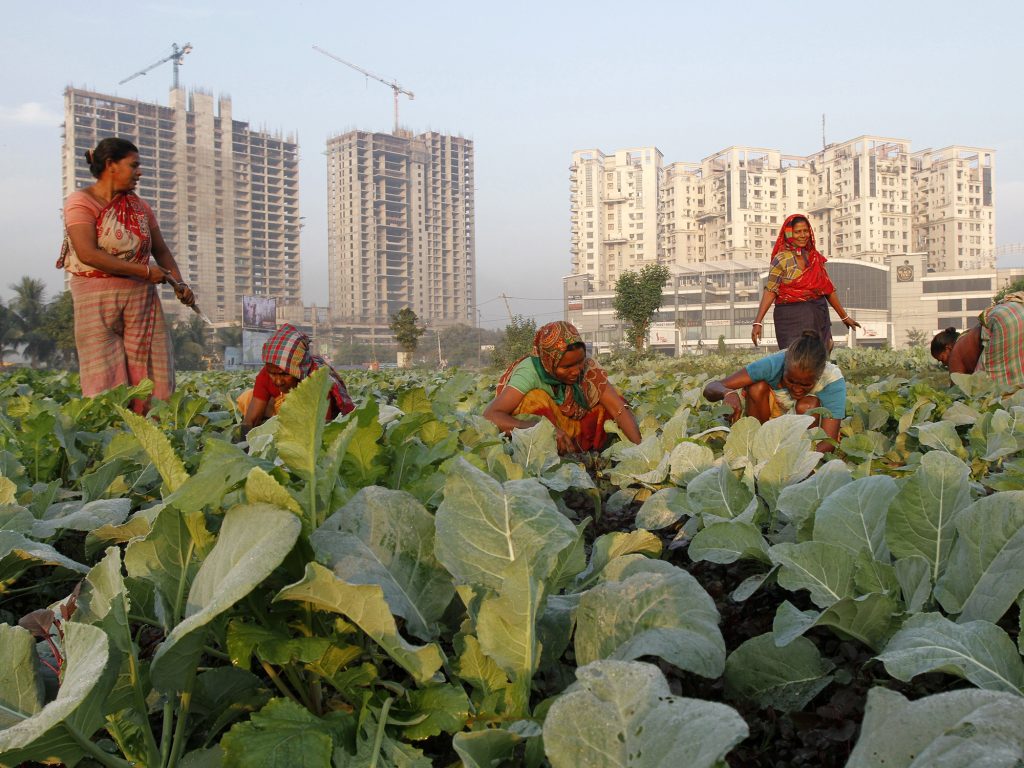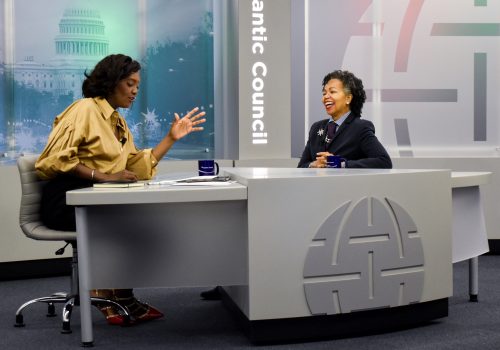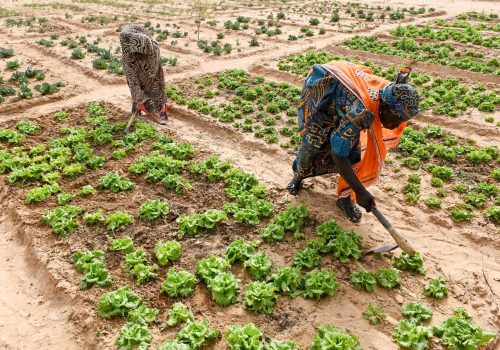This year’s International Women’s Day is taking place against a backdrop of a worldwide inflation surge. Even though inflation may have peaked, its impact—like the pandemic or most economic, social, or environmental shocks—is not shared equally, with women disproportionately experiencing its effects and women in developing countries faring even worse. Yet there are policies and practices that governments, multilateral institutions, and investors (both public and private) can implement in order to help close the gender gap and improve economic resiliency for women.
Inflation affects women by raising the prices of goods and services they consume. Global inflation climbed to nearly 9 percent in 2022, more than double the pre-pandemic worldwide average of 3.5 percent. Emerging and developing economies saw higher inflation, with some experiencing staggering rates of 25 percent or higher. Soaring food and fuel prices, in particular, have pushed more than seventy million people into poverty worldwide.
But the already-high prices of products that women often buy (the so-called “pink tax”) are rising even higher. For example, the consumer price index of beauty products in Mexico and France rose about 13 percent, while in South Korea, the index rose 10 percent. An inflation analysis in the United Kingdom showed that price hikes were higher on women’s shoes, blouses, socks, and other products than those aimed at men. Feminine-hygiene product prices have also soared worldwide, impacting generations of women.
At the same time, women are also deeply impacted by surging food, fuel, and fertilizer prices—driven up by Russia’s war in Ukraine—which are worsening food insecurity. As compared to men, women worldwide tend to do the majority of household shopping and therefore are confronted with the burden of choosing how to adapt weekly purchases. They also spend a larger share of their incomes on food than men, with even greater disparities shown across the Global South, meaning that inflation cuts deeply into their disposable income or ability to save.
Women also play a significant role in farming, agricultural production, and other activities across food systems; however, they have less access to resources such as land or transport, and the increased prices of fertilizer disincentivize its use, inhibiting yields and earnings. According to the Food and Agriculture Organization of the United Nations, in 2021, 31.9 percent of women faced moderate or severe food insecurity compared to 27.6 percent of men. The disparity—4 percentage points—is expected to be even larger in 2022 due to inflation.
The widening gender pay gap is compounding inflation’s impacts. While there had been limited progress in some countries over the past decade, women’s wages generally remain lower than men’s, and inflation is putting any recent advances in gender parity at risk. Moreover, men are more likely to receive a raise at or over the inflation rate, as evidenced, for example, by a 2022 US survey that found that men are 33.3 percent more likely than women to see their salary keep pace with inflation. In low- and middle-income countries—where women often make up a larger share of lower-skill, lower-paying jobs, including in the informal sector—issues of wage disparity and stagnation are even more problematic.
Inflation further bears down on older women who, after leaving the workforce, face not only rising health care costs but also a significant pension gap—26 percent across Organisation for Economic Co-operation and Development countries. In addition, the asset values and investment performances of their pensions are generally more at risk with high inflation. And of the people worldwide who are not receiving a regular formal pension, two-thirds are women.
Interest rates are rising in response to inflation, worsening a picture that is already bleak for women searching for loans to pay for their education, homes, or small businesses. Given the perceived risk of lending to them, women already tend to face higher interest rates and tighter credit markets. In the United States, for example, women pay more for mortgages in nearly every state. Because women in lower-income countries are generally less able than men to receive loans or credit from commercial banks, they utilize microfinance institutions which are generally more accessible to them but historically have higher rates. The rising debt crisis further threatens the ability of lower- and middle-income governments to provide relief or fiscal stimulus to their citizens, including those most vulnerable.
Womenomics 101
Inflation, the gender pay gap, and unequal access to loans all undermine economic recovery and inclusive growth, especially in the Global South. Womenomics—initially launched by then Japanese Prime Minister Shinzo Abe in 2013 as a policy agenda to increase women’s labor-force participation and reduce pay disparity—recognizes that advancing women’s economic empowerment increases growth. But what does a Womenomics agenda for an inflationary era look like?
As a matter of practice, it should start with listening to women of diverse ages, identities, ethnicities, geographies, education levels, marital statuses, or socio-economic statuses to understand their lived experiences, aspirations, and constraints so that the most effective solutions can be created.
Here are some of the measures that can start to tackle gender gaps in wages, wealth, and well-being:
Tax and tariff reductions. These can be used to reduce the economic burden of shocks on women. In 2004, Kenya repealed its value added tax on pads and tampons; many countries and jurisdictions have followed suit, but more such policies are welcome and could prove a powerful counter-inflationary tool for hundreds of millions of women. (Even better would be making period products free altogether, like Scotland has.) On tariffs, a recent World Bank study of fifty-four developing countries found that, because women tend to spend a larger share of their income on food, a high-tariff good, eliminating import tariffs could allow female-headed households to gain 2.5 percent real income (adjusted for inflation) relative to male-headed ones.
Funds for emergencies. In the near term, governments, multilateral institutions, and development partners should allocate more resources and funding to emergency measures and social protections that can greatly impact women including food aid, cash transfers, and pensions. At the same time, governments, multilateral institutions, and development partners can shore up women’s economic resilience for the long term with investments and initiatives geared toward increasing their earnings, wealth, skills, savings, and financial security—and thus their abilities to withstand shocks when prices spike. In India, for example, one experiment found that when governments gave women COVID-19 workfare payments, those women were able to find and take on additional earning opportunities.
Lifting of capital constraints and support for counter-inflationary financial inclusion. Service providers and investors (in both the private and public sectors) can offer loan moratoria and debt restructuring, increase targeted and concessionary lending, and provide insurance or other agriculture, asset, and wealth protections for women. For example, the Australian government funds the Investing in Women program that uses blended finance, private-sector engagement, and other tools to promote women’s economic empowerment and equality across Southeast Asia. Service providers and investors could also extend the special programs they previously introduced to help people, farms, and firms weather COVID-19 economic shutdowns. For example, the South African government introduced its Small, Medium, and Micro Enterprise Debt Relief Scheme in 2020, prioritizing businesses owned by women, youth, and disabled people.
Improvements to women’s technological access. In the three policies above, leveraging digital tools is essential for expanding the reach, inclusivity, and scale of a gender-sensitive response to inflation and to advancing a Womenomics agenda more broadly. The United Nations acknowledged this importance by giving this year’s International Women’s Day the theme, “DigitALL: innovation and technology for gender equality.” Digital tools have great power in advancing a Womenomics agenda, for example by improving labor-market information systems or government technology services, or by facilitating safer blockchain or digital-currency payments and fintech services. Research from the International Monetary Fund found that fintech increases the number and ratio of female employees in the workforce and also mitigates the financial constraints that female-headed firms face.
Improvements in care infrastructure and availability. Childcare, eldercare, disability care, and the addition of such care facilities in the workplace can help pave the way for women’s economic participation and financial security. A recent study of publicly provided childcare in Brazil showed positive effects on the incomes and labor-market activity of caregivers, the majority of whom are women.
Above all, ensuring women with diverse experiences are at the table and playing a more meaningful role in economic and fiscal policy and decision-making—and implementation—is critical to closing the gender gaps in wages, wealth, and well-being.
Nicole Goldin is a nonresident senior fellow at the GeoEconomics Center and global head of inclusive economic growth at Abt Associates, a consulting and research firm.
Further reading
Thu, Mar 2, 2023
Ukraine’s women are playing a key role in the fight against Russia
UkraineAlert By
From frontline soldiers to unofficial ambassadors, Ukraine's women are playing a key role in their country's struggle to defeat the Russian army and end Vladimir Putin's criminal invasion, writes Adrienne Ross.
Wed, Feb 8, 2023
A more diverse US State Department is taking on its ‘male, pale, and Yale’ legacy
New Atlanticist By
US Ambassador to the UN Linda Thomas-Greenfield and Gina Abercrombie-Winstanley, the State Department’s first ever chief diversity and inclusion officer, spoke at an Atlantic Council Front Page event honoring Black trailblazers in foreign policy.
Fri, Oct 7, 2022
How Niger’s safety net helps its most vulnerable citizens thrive amid crises
AfricaSource By
The World Bank's Wadata Talaka safety-net partnership program with Niger aims to empower women in the country and protect its human-capital gains in the face of overlapping shocks.
Image: Women work in a cauliflower field in Kolkata November 28, 2013. Photo via REUTERS/Rupak De Chowdhuri.



